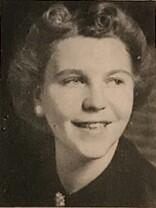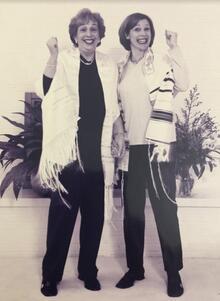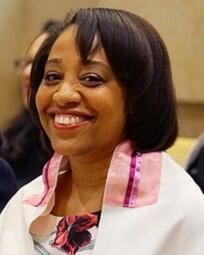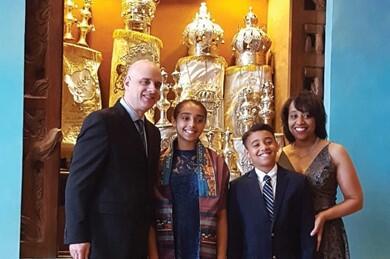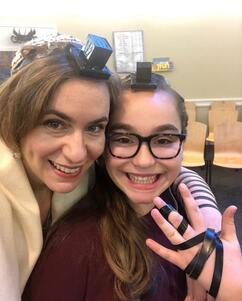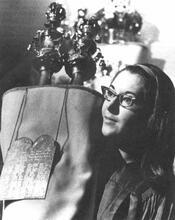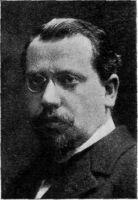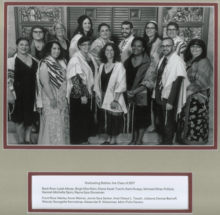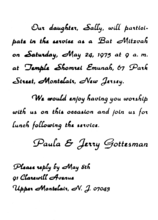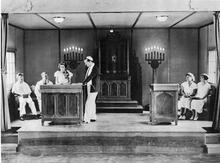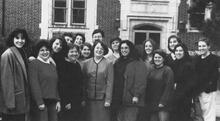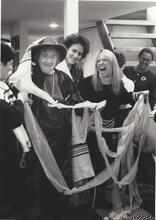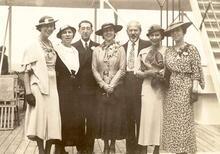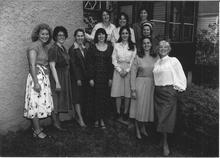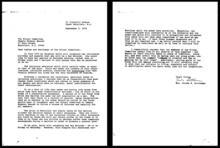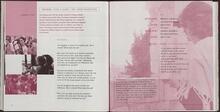Bat Mitzvah: American Jewish Women
A survey of the origins and development of bat mitzvah in the U.S., including European antecedents, and its impact on American Jewish life since the first in 1922. Bat mitzvah pioneers’ stories are told within an historical context, emphasizing responses of Reconstructionist, Conservative, Reform, and Orthodox rabbis. Conceived as a corrective to girls’ exclusion from Jewish study and practice, bat mitzvah became a gateway to egalitarianism in worship, normalized female presence in communal rituals, and authenticated the participation of non-boys and -men in Jewish life, allowing other “minorities” (e.g. adult women, converts, Jews of color, those with cognitive or physical challenges) to ascend the bimah (sanctuary platform). Jewish communities today are stretching to accommodate new ideas about gender in non-binary ceremonies known as B mitzvah.
Introduction
When Judith Kaplan Eisenstein became the first American girl to mark her bat mitzvah (plural b’not mitzvah; bas mitzvah in Jews of European origin and their descendants, including most of North and South American Jewry.Ashkenazic pronunciation) during synagogue worship, she recalled “shock[ing] a lot of people,” especially her disapproving grandmothers. The ceremony took place on Saturday morning, March 18, 1922—two years after women were guaranteed the right to vote in the United States. Twelve-year-old Judith stood below the Lit. "elevated place." Platform in the synagogue on which the Torah reading takes place.bimah (sanctuary platform) “at a very respectable distance from the Torah,” she recalled decades later. She read a selection from the Book of Leviticus from a humash (a Torah in printed form) only after her father had finished chanting the standard weekly reading from the holy scroll itself. While Judith’s bat mitzvah ceremony heralded an unprecedented level of gender parity in Jewish religious life and proved epically symbolic, it was not equivalent to Lit. "son of the commandment." A boy who has reached legal-religious maturity and is now obligated to fulfill the commandmentsbar mitzvah.
Today, North American girls across the Jewish spectrum, from secular to ultra-Orthodox, mark their coming-of-age in various forms. In less than a century, the mere blink of an eye in the long Jewish past, the ceremony has evolved from radical innovation to mainstream expectation.
Bar mitzvah is the ritual that signifies a boy’s entrance into religious majority at age thirteen. To mark the occasion, he is customarily called up to the bimah to bless the Torah she-bi-khetav: Lit. "the written Torah." The Bible; the Pentateuch; Tanakh (the Pentateuch, Prophets and Hagiographia)Torah (known as aliyah; literally, “going up”) for the first time, an honor he will reenact for the rest of his adulthood. He may also read from the scroll; if the day chosen to mark the milestone is a Sabbath, he usually chants the haftarah, the prophetic portion of that week, as well. Boys have marked their b’nai mitzvah since the Middle Ages.
Jewish tradition ordains that girls automatically reach religious maturity at the age of twelve. But historically a girl’s transition from child to adult was not marked communally, either in or outside a synagogue. Women had no part in the public reading of the Torah, except as listeners, segregated in the women’s gallery. Thus, when bat mitzvah emerged as a regularized rite in the Jewish lifecycle of a girl, the procedure varied from synagogue to synagogue and evolved over time. Not until the 1980s and 1990s did the ritual for girls became largely identical to boys’. Formerly, liberal congregations mostly marked b’not mitzvah at Friday evening Sabbath services, when the Torah is not customarily read, although some rabbis allowed bat mitzvah girls to break with convention and chant Torah or Haftarah on a Friday night. In traditional settings, even today bat mitzvah is marked outside of regular Shabbat worship, either after the service is completed, on a day that is not Shabbat, or at a woman’s tefillah group––where a girl is permitted to read Torah since technically there is no The quorum, traditionally of ten adult males over the age of thirteen, required for public synagogue service and several other religious ceremonies.minyan without ten men praying together.
Judith’s bat mitzvah ceremony was the brainchild of her father, Rabbi Mordecai Kaplan, who with his wife, Lena, had four daughters. As he explained in a 1965 letter congratulating his colleague, Abraham Joshua Heschel, on the bat mitzvah of his daughter, Susannah Heschel: “I inaugurated the Bat-Mitzvah celebration with my oldest daughter Judith . . .. She was the first of the four reasons for my doing that, the other three also being girls.”
Within two months of Judith’s ceremony, Kaplan’s congregation, known as the Society for the Advancement of Judaism, instituted a prescribed course of study for bat mitzvah girls and readied a certificate to commemorate the event. However, it would take decades for bat mitzvah to catch on at SAJ, even as it became a center for the Reconstructionist ideology Kaplan propagated from the 1930s on. The toppling of the reign of gender-segregated religious roles at the birthplace of American bat mitzvah would not come until 1950, after a prolonged struggle fought by post-bat mitzvah girls.
Though it started with Reconstructionism, the propagation of the bat mitzvah in the United States fell mostly to the Conservative movement, given Kaplan’s presence as a professor at its flagship Jewish Theological Seminary and the absence of an independent institution for training Reconstructionist rabbis until 1968. Conservative rabbis debated throughout the twentieth century whether granting bat mitzvah girls permission to perform synagogue rituals would be a onetime privilege or an ongoing right that would extend over a lifetime. In the meantime, most Reform rabbis initially had little interest in bat mitzvah because of their attachment to the rite of confirmation for boys and girls. A number did, however, introduce bat mitzvah, along with their Conservative colleagues, in the 1940s and 1950s. To take one striking example, the Isaac M. Wise Temple in Cincinnati––which has been playfully called the “Mother Church” of the Reform movement––held its first bat mitzvah ceremony for thirteen-year old Judith (Hyman) Darsky on April 23,1955.
In contrast to bat and bar mitzvah, confirmation is an egalitarian rite based on the model of Christian catechism, whereby after a period of study, the confirmand displays mastery of religious principles. Instituted by Reform rabbis in nineteenth-century Europe as a replacement for bar mitzvah, which they regarded as both antiquarian in its inattention to doctrine and outdated in its exclusion of girls, confirmation had its American debut at New York’s Congregation Anshe Chesed in 1846. The ceremony customarily takes place on or close to the festival of Shavuot, given its association with the giving of the Torah recorded in the Book of Exodus, and functions largely today as a graduation rite of sorts after completion of several years of religious training post-bar or –bat mitzvah.
Meanwhile, the strictures of The legal corpus of Jewish laws and observances as prescribed in the Torah and interpreted by rabbinic authorities, beginning with those of the Mishnah and Talmud.halakhah (Jewish law) made bat mitzvah only a figment in the Orthodox imagination until second-wave feminism asserted itself among pioneering women who promoted egalitarianism within the framework of Jewish law.
Bat Mitzvah’s Emergence in Nineteenth- and Early Twentieth-Century Europe
Although Kaplan is credited with inaugurating the bat mitzvah ceremony in the United States, related rituals had already emerged by the nineteenth century in traditional Jewish communities in Italy, France, and the Ottoman Empire. To mark their bat mitzvah, girls of Turin and Milan dressed in white and wore flower wreaths on their heads at special gatherings held at synagogue on weekdays. The girls took turns reciting prayers before the ark in the presence of the chief rabbi. As recorded in his diary, Mordecai Kaplan witnessed such a rite in Rome, though it was not the impetus for Judith’s ceremony, which occurred several months before his trip. Italian Jews imported this custom to Alexandria and Tunis, where they immigrated in the 1930s.
In France, too, it seems bat mitzvah was communally acknowledged before the twentieth century. Rabbi Avraham Musafiya confirmed in a handwritten, nineteenth-century Halakhic decisions written by rabbinic authories in response to questions posed to them.responsum (legal answer to a religious question)— later quoted by the Descendants of the Jews who lived in Spain and Portugal before the explusion of 1492; primarily Jews of N. Africa, Italy, the Middle East and the Balkans.Sephardic chief rabbi of Israel, Yitzhak Nissim (1896-1981)—that in cities and towns across France it was customary to make a seudat mitzvah (obligatory festive meal) for “a boy and also for a girl” when he or she came of age. In Baghdad, Rabbi Yosef Hayim (ca. 1833-1909) recommended that girls mark their twelfth birthdays in liturgical fashion, with options ranging from wearing festive clothing to reciting shehecheyanu (the blessing of beginnings).
Bat mitzvah made early inroads in liberal Judaism as well. Dr. David Kaufmann (1852-1899), a member of the “positive historical school” regarded as the European precursor of the Conservative movement, stated a preference for bat mitzvah over confirmation for girls. Writing in 1893 Budapest, he asked rhetorically: “Wouldn’t it be better to call up our girls as Bar Mitzvah [sic] to the Torah exactly like the boys? . . . Jewish domestic and community life will gain extraordinarily if the women will be deemed worthy of this religious practice.” Rabbi Yehezkel Caro of Lemberg, Austria (present-day Lviv, Ukraine), held a bat mitzvah celebration at his Reform temple in 1902, while a protest ensued outside the sanctuary. Rabbi Mordecai Ehrenpreis, who studied at the Hochschule in Berlin and avidly supported teaching Hebrew to boys and girls, defended bat mitzvah in the Russian-language periodical Voskhod.
Bat Mitzvah Comes of Age in the United States
Bat mitzvah was not an overnight sensation in the United States. In the 1920s, only SAJ held such ceremonies, though Rabbi Elias Margolis (a Reform movement ordinee and brother of historian Max Margolis) launched a bat mitzvah class in 1924 at Congregation Emanu-El, a Conservative synagogue in the suburbs of New York. In a 1931 survey of 200 Conservative rabbis, only six of the 110 respondents had adopted bat mitzvah in their synagogues, and many had never even heard of it. Among Reform rabbis, confirmation remained the coming-of-age ceremony of choice for both boys and girls; indeed, it replaced bar mitzvah in some Reform temples until the last quarter of the twentieth century, by which time the latter was restored and bat mitzvah was introduced.
B’not mitzvah of the 1930s were few in number and occurred generally in arenas where Kaplan’s influence held sway. Gayola Goldman (1919-2011) marked her bat mitzvah in 1931 at Chicago’s Anshe Emet, where her father Rabbi Solomon Goldman presided. A devotee of Kaplan, Goldman began to serve the Chicago congregation after leaving Cleveland’s Jewish Center in 1929, where he had been sued for introducing mixed seating. When Goldman died suddenly in 1953, it was Judith Kaplan Eisenstein’s husband, Ira, who came to serve the congregation for a brief stint.
During the same decade, bat mitzvah found a hospitable home at a pair of summer camps: Cejwin in Port Jervis, NY, and Modin in Canaan, Maine. In the great outdoors, where informality reigned, girls were permitted to mark their b’not mitzvah during Sabbath morning services. It didn’t hurt either that the camp directors were fierce Kaplanian disciples: Dr. Albert P. (1894-1980) and Bertha (Singer, 1897-1974) Schoolman founded the former on behalf of the Central Jewish Institute; Dr. Alexander M. (1890-1976) and Julia Dushkin (Aronson, 1895–1975) opened the latter with Isaac B. (1892-1975) and Libbie (Suchoff, 1891-1970) Berkson.
Gladys (Saltpeter) Kraft (b. 1923), who became bat mitzvah at Cejwin in 1935, recalled Mordecai Kaplan being a frequent visitor to camp and Judith heading up the music program. Despite being the directors’ daughter, Kinereth (Dushkin) Gensler (1922-2005) was denied the chance to chant from the Torah scroll at her 1935 bat mitzvah at Modin because she got her period, a heartbreak she eulogized in verse.
Among the handful of known ceremonies in the same decade is that of Alys Ruth Pritzker, who rode her twin brother’s bar mitzvah suit coattails to the bimah of Temple of Aaron, a Conservative synagogue in St. Paul, Minnesota, in 1932. As her father Leo said, using his children’s nicknames, “If Sonny can be bar mitzvahed, Sissy can become bat mitzvahed.”
The 1940s saw a growth in bat mitzvah ceremonies triggered by a desire to bolster Jewish education for girls. By the end of the decade, one-third of Conservative congregations had instituted the rite as its visibility prodded Reform and Orthodox rabbis to consider instituting it as well. In 1943, after attending her friend Charlotte Sommer’s ceremony at the neighboring Conservative synagogue, Beth El, Barbara (Trustin) Taxman convinced her Reform rabbi, Arthur J. Lelyveld (1913-1996), to allow her to be the first bat mitzvah at Temple Israel of Omaha, Nebraska. In the spring of 1944, a mother asked Orthodox rabbi Jerome Tov Feinstein of Brooklyn’s Congregation Anshe Emes: “Why don’t you do something for the girls?” By fall, he had organized a bat mitzvah class, arguing that girls should be given opportunities to “eliminate the feeling that in the Orthodox synagogue [they] do not count.”
The number of ceremonies climbed steadily in the 1950s. More than one-half of all Conservative and more than one-third of Reform congregations implemented bat mitzvah by mid-century. Marilyn Moskowitz described her 1953 group bat mitzvah in Hollis Hills, New York, as “sort of an experiment.” The congregation was trying to decide “whether girls could learn enough to be counted in a The quorum, traditionally of ten adult males over the age of thirteen, required for public synagogue service and several other religious ceremonies.minyan one day.” Marilyn knew that traditionally only men were counted in the quorum of ten required for full worship. But, she said, “after our bat mitzvah, they would count two women for a man until they finally went to one-to-one.”
Even as bat mitzvah ceremonies proliferated, the sight of a girl on the bimah sent shockwaves through American Jewish communities. Sandra (Jacoby) Klein recalled of her 1950 bat mitzvah at Valley Jewish Community Center in North Hollywood, California: “The elders in the congregation threw their Four-cornered prayer shawl with fringes (zizit) at each corner.tallesim over their heads and walked out!” Margie (Tarmy) Berkowitz, who became bat mitzvah at Temple Emeth in Brookline, Massachusetts, in 1956, reminisced about her zayde (grandfather) asking her until the day he died when she was sixteen: “‘Margelle, chant your haftarah.’ As she explained, “He couldn’t believe that a girl could become bar mitzvahed (his words).”
While it would take far more girls on the bimah for bat mitzvah to reach a tipping point, rabbis of the 1960s regarded the rite as a boon. As the ceremonies were typically relegated to Sabbath evenings, they were pleased to see a spike in attendance at Friday night services. Rabbi R.A. Ohrenstein of Knesset Israel Congregation in Pittsfield, Massachusetts, extolled the “more modest and dignified Oneg Shabbat” (reception) of bat mitzvah. He hoped it would help tone down “the spirit of the bar,” which he believed was “too often prevalent at the religious initiative of a boy.”
Bat mitzvah rode 1970s second-wave feminism to new heights. The ceremony became all but ubiquitous in Conservative and Reform congregations as female rabbis joined the girls on the bimah for the first time. Judith Kaplan’s bat mitzvah took place 50 years before Sally Priesand became the first woman rabbi in US history. For a half-century, twelve- and thirteen-year-old girls had pushed the needle of Jewish history forward. Bat mitzvah girls had normalized female presence on the bimah in a majority of synagogues, paving the way for female rabbis to take the stage.
Meanwhile, more traditional communities began to mark bat mitzvah publicly, though outside regular Sabbath worship. Some read Torah at all-women tefillah groups; others spoke before a mixed congregation after services. Lynne Jacobson Arons described her 1970 service at the Iran Hebrew Congregation in Skokie, Illinois: “It was a Sunday morning, and all the men were wearing tefillin, the women had on beautiful hats. When it was time for me to read the haftarah, I came up to the bimah.” “The men,” she added, “sat behind the Synagogue partition between men and womenmehizah.”
With the women’s movement at their backs, bat mitzvah girls and their advocates fought for equality. Sally Gottesman lobbied to have the first Saturday morning bat mitzvah at her Conservative synagogue, Temple Shomrei Emunah of Montclair, New Jersey, in 1975. Amanda Newman’s mother, who would later become president of the Jewish Orthodox Feminist Alliance, was insistent that her daughter speak from the rabbi’s lectern during her bat mitzvah speech, which she delivered after Sabbath services at the Modern Orthodox Congregation Kehilath Jeshurun in New York City in 1978. When Amanda finished, she recalled, “Rabbi [Haskel] Lookstein had everyone stand in my honor as I walked to my seat [from his lectern], as you would rise for a great teacher. It was extraordinary.”
As bat mitzvah became well-established during the last-quarter of the twentieth century, women (and men) who had missed the ceremony as adolescents—either because they were not offered it or hadn’t chosen it or weren’t Jewish at the time—jumped at the opportunity to study in synagogue-based classes that often culminated in group adult b’not and b’nai mitzvah. After being denied a bat mitzvah ceremony in 1963, Catherine Magid returned to her hometown of Greensboro, North Carolina, in 1999 and joined her mother, Lois, who had been confirmed as a teen in Wallingford, Connecticut, to prepare for the rite together. About their service at Temple Emanuel, Catherine said, “I could remember all the [Hebrew] letters, and Mother had the vowels. I think we succeeded because we both got part of it right.”
By the end of the twentieth century, the bat mitzvah came to look identical to the bar mitzvah in all but traditional congregations, and even ultra-Orthodox Jews embraced them. In 1993, Chabad-Lubavitch created “Bat Mitzvah Clubs” designed to empower every eleven- to thirteen-year-old girl “to become a strong, smart, spiritual individual who understands there’s more to a Bat Mitzvah than a party.” Felissa Rubin became bat mitzvah during a woman’s prayer service in Miami on a Shabbat morning in 2000, as sanctioned “by one of the most respected emissaries of Chabad-Lubavitch,” according to her father. Before the service, Felissa practiced holding the heavy Torah, fearing she would drop it in the moment. “But on that day,” she said, “it felt as light as a feather.”
In the twenty-first century, with rising awareness of the spectacular diversity among Jews, those who become bat mitzvah are being acknowledged as well for bringing their unique identities and life experiences to Jewish communities across the globe. Born and raised a Jew, Anna Drangel walked a straight path from birth to bimah to become bat mitzvah on September 22, 2018, at the age of thirteen at the Reform Temple of Forest Hills in Queens, New York. “It’s what all my Jewish classmates were doing,” she said. For her mother, Gina (Jones) Drangel––who was baptized as a baby and came of age as a Black girl in the Catholic Church––it was hardly a foregone conclusion that she would one day become bat mitzvah like her daughter. But she did, at age 48, just months before her daughter. With wisdom far beyond her years, Anna observed how the rite of bat mitzvah conferred a different status on her than her mother. “My bat mitzvah meant that I was on my way to becoming a Jewish woman,” she said. “But for my mom, her bat mitzvah validated her as a Jewish woman.” “Not that she was any less Jewish before the ceremony,” she added.
In many ways, Ma’ayan Rosenbaum’s bat mitzvah alongside her twin brother, Aviv, on November 9, 2019, represents the fulfillment of the egalitarian promise of Judith Kaplan’s bat mitzvah first. Ma’ayan did not for a moment doubt that she would participate in the Torah service on par with Aviv. “I don’t think I would have done more or less had I not done the service with my brother,” she said, “and I don’t think he would have done more if he had not done it with me.”
The Thursday before the big day, Ma’ayan celebrated her bat mitzvah with her classmates during morning worship at the Jewish Community Day School in Watertown, Massachusetts. Like the boys in her class who turned thirteen, she, too, wrapped tefillin for the first time—an embodiment, one might say, of her coming of age.
Ma’ayan’s tefillin have special significance. They belonged to her grandmother, Professor Paula Hyman (1946-2011), the doyenne of American Jewish women’s history, who was the first to investigate the history of bat mitzvah, among countless other topics, one of the luminaries to whom this encyclopedia is dedicated, and the original author of this entry. She died when her twin grandchildren were just five. “I like to think my grandmother wore these,” Ma’ayan said, “and when she did, it was considered very, very strange. Now I’m getting to wear them and people are like, ‘Oh, it’s just a girl wearing tefillin at her bat mitzvah.’”
Bat Mitzvah’s Revolutionary Impact
Until recently, the details of bat mitzvah were hidden in scrapbooks and photo albums, in remembrances and family lore. Details have come to light in new studies, oral histories, and a national traveling museum exhibit devoted to the topic. Seemingly trivial matters add substantially to the bat mitzvah narrative. At her 1966 bat mitzvah in Gary, Indiana, Malka Alpert Young described wearing a dress with a blue-and-white-striped top with a white skirt at the bottom. “‘Like a tallis,’ my mother said.” Her dress speaks to the novel dilemma of finding an appropriate “bar mitzvah suit” for a girl and the confounding question of whether she would be allowed to wear ritual garb like boys.
Many tell of the profound effect their bat mitzvah ceremonies had on them. As the first woman to become bat mitzvah in (Rutland) Vermont, Betsy Ravit Chase recalled how her 1952 mitzvah provided a sense of empowerment that has remained to this day. “I realized,” she said, “that I could take my place in the Jewish community as a member and a leader.”
B’not mitzvah chiseled away at the gender divide between men and women and brought about a revolution in Jewish life. Conceived as a corrective to girls’ exclusion from Jewish study and practice, bat mitzvah was initially instituted as a complement to bar mitzvah but not necessarily a gateway to their equal and regular participation in worship. However, with each successive bat mitzvah, the Jewish public became accustomed to seeing girls front and center in prayer life. As they ascended the bimah in ever increasing numbers, girls—and the women who followed them as adult b’not mitzvah—expanded the parameters of who gets to do Jewish, who gets to learn Jewish, and what Jewish looks like. That is to say, bat mitzvah girls authenticated the participation of non-boys and -men in Jewish life. Their growing presence on the “stage” (bimah) of Jewish communal life eventually became acceptable and accepted. Girls were the first “minority” to ascend the bimah but not the last.
A coming-of-age ceremony is now regarded as the prerogative of every person who identifies as a Jew across the communities of North American Jewry. Tween to senior. Secular to observant. Born Jew or convert. Of color and white. Individuals with cognitive or physical challenges. Queer and straight. Every Jew, any Jew, who masters the requisite skills is eligible.
Gender-Neutral Coming-of-Age Ceremonies
For their Jewish coming-of-age, Soren Clare Barnett was called to the Torah twice: first as a bat mitzvah at a synagogue in the New Jersey suburbs at the age of thirteen and later as a bar mitzvah in Jerusalem as a participant in Birthright Israel, the all-expense paid trip to Israel for young adults. Soren explained: “I didn’t question my gender identity until my junior year of high school. I identified as a female then because I didn’t know there was another possibility.” As a gender non-conforming individual who now uses the pronouns they/them, Soren dreams of a Jewish community where every teenager can come of age in a ceremony representative of their identity.
Soren’s dream is materializing, as some communities stretch to accommodate new ideas about gender. Ruby Marx decided to do “something in the middle” for their rite of passage in 2020. “Judaism is a big part of my family—we keep kosher and my older sister had a bat mitzvah, so I knew I would have to have one too. But I didn’t want to be called a girl, which is a traditional part of the ceremony. And I didn’t want a bar mitzvah either.” Ruby became the first “B mitzvah”—the name for a coming-of-age ceremony that avoids gender altogether—at Temple Beth Zion in Brookline, Massachusetts. Additional communities are following suit, propelling the Reform movement to assemble a toolkit to help synagogues tailor ceremonies to align with a child’s gender identity.
One of the obstacles to creating a gender-neutral or gender-inclusive ceremony is the nature of the Hebrew language. Keshet (literally, “rainbow”), a non-profit devoted to LGBTQ equality in Jewish life, has posted “A Guide for the Gender Neutral B-Mitzvah.” Best practices include modifying the customary language for calling up a teen for an aliyah from “bar/son of ____” or “bat/daughter of ____” to “mibeit/from the house of ____.”
B mitzvah is the latest challenge to the longstanding gendered differentiation of Jewish practice and roles. While it may be the newest frontier, it is decidedly not the first and likely not the last. Just ask any bat mitzvah pioneer.
Direct quotations are from interviews with the author unless otherwise indicated below. The author acknowledges the role of Sally Gottesman and Moving Traditions in instigating research on the topic of bat mitzvah pioneers.
Balin, Carole B. “Bat Mitzvah’s Delayed Coming-of-Age in Reform Judaism.” CCAR Journal (Fall 2012): 23-35.
Dickstein (Kominers), Ellen, interview of Judith Kaplan Eisenstein. November 1, 1974 (files of Pamela Nadell).
Eisenberg, Azriel, ed. Eyewitnesses to American Jewish History 4. (1982), 30-32.
Eisenstein, Judith K. “Looking Back: A Career in Jewish Music,” 17-page typewritten manuscript (files of Pamela S. Nadell) (short excerpts published in The Reconstructionist (Jan-Feb 1987).
Eisenstein, Ira. “Sex Equality in the Synagogue.” The Reconstructionist 19, no. 2 (March 6, 1953): 18-20.
Eleff, Zev. “How Bat Mitzvah Became Orthodox” (chapter 2). In Authentically Orthodox: A Tradition-Bound Faith in American Life. Detroit: Wayne State University Press, 2020.
Gensler, Kinereth. Journey Fruit: Poems and a Memoir. Farmington, ME: Alice James Books, 1997 (contains poem about her experience as a bat mitzvah at Camp Modin).
Golinkin, David. “The Participation of Jewish Women in Public Rituals and Torah Study, 1845-2010.” Nashim 21 (Spring 2011): 46-66.
Goodblatt, Morris S. “Synagogue Ritual Survey.” Proceedings of the Rabbinical Assembly (1948): 105-9.
Hyman, Paula E. “The Introduction of Bat Mitzvah in Conservative Judaism in Postwar America.” YIVO Annual 19 (1990): 133-146.
Joselit, Jenna Weissman. “Red-Letter Days” (chapter 3). In The Wonders of America: Reinventing Jewish Culture, 1880-1950. New York: Hill and Wang, 1994.
Marcus, Ivan. Rituals of Childhood: Jewish Acculturation in Medieval Europe. New Haven: Yale University Press, 1996.
Marcus, Joan. “A Family’s 50 Years at Temple,” Jewish Press, Omaha, NE (April 15, 1997): 14ff.
Meyer, Michael. Response to Modernity: A History of the Reform Movement in Judaism. New York: Oxford University Press, 1988: p. 472, n. 73.
Silverman, Morris. “Report on Survey on Ritual.” Proceedings of the Rabbinical Assembly Vol 4 (1930-32): 322-40.
Stein, Regina. “The Road to Bat Mitzvah in America.” In Women and American Judaism: Historical Perspectives, edited by Pamela S. Nadell and Jonathan D. Sarna. Hanover and London: University Press of New England, 2001, pp. 223-234.
Vinick, Barbara and Shulamit Reinharz, eds. Today I am a Woman: Stories of Bat Mitzvah around the World. Bloomington and Indianapolis: Indiana University Press, 2012.
Waxman, Deborah. “A Lady Sometimes Blows the Shofar”: Women’s Religious Equality in The Postwar Reconstructionist Movement.” In A Jewish Feminine Mystique?: Jewish Women in Postwar America. Rutgers University Press, 2010: 87-104.
Wolfson-Moche, Nancy. “One Family’s Solution.” In Toward a Meaningful Bat Mitzvah. Aventura, FL: Targum Shlishi, 2002: 11-14.
A selection of information about bat mitzvah on JWA (in addition to hyperlinks embedded in encyclopedia entry)
https://jwa.org/blog/my-bat-mitzvahs-bat-mitzvah
https://jwa.org/blog/expanding-bat-mitzvah
https://jwa.org/blog/batmitzvah-balancing
https://jwa.org/blog/Judith_Kaplan
https://jwa.org/blog/kaganbatmitzvah
https://jwa.org/blog/power-of-bat-mitzvah
https://jwa.org/blog/risingvoices/whose-bat-mitzvah-is-it-anyway
https://jwa.org/blog/risingvoices/my-big-fat-feminist-bat-mitzvah
https://jwa.org/blog/jewish-girls-guide-to-bat-mitzvah-project
https://jwa.org/blog/risingvoices/how-my-bat-mitzvah-changed-my-life
https://jwa.org/blog/my-super-uncool-roller-skating-bat-mitzvah
https://jwa.org/blog/my-out-of-this-world-bat-mitzvah
https://jwa.org/blog/6-bat-mitzvah-gifts-to-look-at-before-writing-check
https://jwa.org/blog/learning-and-teaching-bat-mitzvah-it-goes-both-ways
https://jwa.org/blog/artist-miriam-karp-on-making-her-daughters-bat-mitzvah-tallit
https://jwa.org/teach/mbms
https://jwa.org/article/introduction-bat-mitzvah-and-communal-change
https://jwa.org/thisweek/mar/18/1922/judith-kaplan
https://jwa.org/blog/quinceanera
https://jwa.org/teach/golearn/mar09/family
https://jwa.org/blog/rebecca-lubetkins-60th-bat-mitz-versary
https://jwa.org/blog/risingvoices/secular-bat-mitzvahs-yes-they-do-exist
https://jwa.org/podcasts/canwetalk/episode-28-torah-at-her-fingertips


